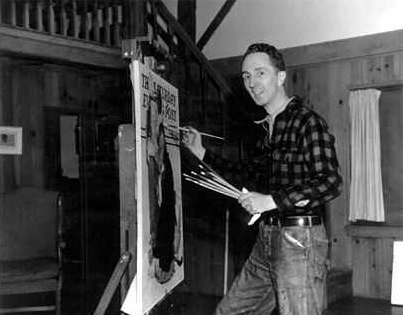Norman Rockwell
Publié le 17/11/2012

Extrait du document

Norman Rockwell was a 20th-century American painter and illustrator. He was born third february, 1894 and died November 8, 1978. His works enjoy a broad popular appeal in the United States for their reflection of American cultureNorman Rockwell's style has been described as storyteller I will now begin the description and analysis of work Triple Self-Portrait. It was painted in 1960 for the cover of Saturday Evening. We see the artist's back, sitting on a stool. He leans to look in a mirror on a chair. His hand is still with the brush on the canvas in front of him and where begins to reveal its self-portrait. The painter and his image in the mirror correspond perfectly : same size, same glasses, same shirt etc. The self-portrait on canvas is without glasses and nicely stylized. The painter looks younger, his face is rounder. The pipe that he smokes is horizontal, not falling as in "reality". There are three portraits on the canvas. That is why the title is Triple self-portrait. The first self-portrait is face in the mirror, where we see the face and bust of the painter. The second portrait is on the canvas, where he is represented more younger. The third self-portrait shows the artist in whole but he is back. Clinging to the left of the canvas a sheet of sketches of the self-portrait (four heads and hand holding a pipe) and right, reproductions of four famous self-portraits: Dürer, Rembrandt, Picasso, and Van Gogh. we can see on the floor brushes, a tube of paint and a wastebasket where smoke escapes. The smoke seems a reference to autobiographical anecdote : the painter has burned a basket with the ashes of his pipe. The fire caused the loss of various objects, in particular historical costumes collected by the painter. The presence of military helmet placed on the canvas, pipe, and the smoke escaping from the wastebasket are probably referring the fire. I will now try to make a interpretation of the work. The canvas shows the artist who looking in the mirror and realize it's self-portrait. This is a mise en abyme. Moreover, Rockwell represents four self-portraits for painters Dürer, Rembrandt, Van Gogh and Picasso, in his own self-portrait. It is also a mise en abyme. The differences between the three portraits invite the viewer to wonder: what isself-portrait fairest, the most faithful to reality? Any representation, is it not alwaysmisleading? The portrait on the canvas seems more flattering: the painter is younger, rounder face, he does not have glasses. The painter seems to tell us that make his self-portrait is lying, improve reality. However, it is the only portrait which contains the signature of the author. Does this say that it is the only one he claims ? The portrait in the mirror mask the eyes of the painter and this is quite embarrassing . Furthermore, it throws new suspicion on the portrait he does : if he does not see very well, how can it accurately represent? The third self-portrait, back, would it be more "real"? Unflattering because of the posture of the artist, we can however ask by what means the artist can represent it back? Norman Rockwell represents three different self-portraits of the artist, he shows that any representation is ephemeral: it ages; misleading: it is a reflection, and fake : it reflects what the artist wants to show. The artist incorporates the past (by the representation when he is younger) and the present (the artist back). It mixes the genres of self-portrait of this representation and that of autobiography allusion to the story of the fire. The elements of military (eagle and helmet), as in the portraits of the great generals contrast with the rest of the decor in disarray : full trash, brush and tube of paint on the floor, a glass of what appears to be Coca Cola on an open book. In conclusion, in this Triple self-portrait, the artist mocks himself. By showing in an unflattering posture and featuring the lie that is at the heart of all self-representation.
Liens utiles
- Essai sur oeuvre artistique en anglais: Norman Rockwell
- Analyse du tableau de Norman Rockwell "the dugout"
- Norman Rockwell, Before the shot (Avant la piqûre), 1958
- Rockwell, Norman - vie et oeuvre du peintre.
- Analyse et Interprétation de la mosaïque "The Golden Rule" de Norman ROCKWELL








